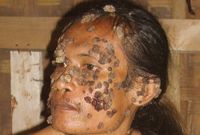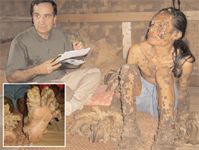- Acne
- Actinic Keratosis
- Aesthetics
- Alopecia
- Atopic Dermatitis
- Buy-and-Bill
- COVID-19
- Case-Based Roundtable
- Chronic Hand Eczema
- Chronic Spontaneous Urticaria
- Drug Watch
- Eczema
- General Dermatology
- Hidradenitis Suppurativa
- Melasma
- NP and PA
- Pediatric Dermatology
- Pigmentary Disorders
- Practice Management
- Precision Medicine and Biologics
- Prurigo Nodularis
- Psoriasis
- Psoriatic Arthritis
- Rare Disease
- Rosacea
- Skin Cancer
- Vitiligo
- Wound Care
Article
Genetic flaw, HPV cause unmanageable tree-like growths
Author(s):
When Discovery Channel invited Anthony Gaspari, M.D., to diagnose what might be causing tree-like structures to grow on an Indonesia man, the suspicion was an extreme case of epidermodysplasia verruciformis. But Dr. Gaspari, professor and chairman of the department of dermatology, University of Maryland School of Medicine, Baltimore, found the man was disfigured by disseminated HPV-2, infection. A genetic flaw robbed Dede, the Indonesian, of his ability to ward off warts that had spread like wild fire around his body-even to the point of causing tree-limb-like cutaneous horns.

Key Points

But Dr. Gaspari, professor and chairman of the department of dermatology, University of Maryland School of Medicine, Baltimore, discovered the man was disfigured by disseminated HPV-2 infection.
A genetic flaw had robbed "Dede," a 35-year-old father of two, of his ability to ward off warts that had spread like wildfire across his body - causing tree-limb-like cutaneous horns on his hands and feet.
"I was shocked by his physical appearance and had never seen anything that severe in my career," Dr. Gaspari says.
Dr. Gaspari says he saw "someone that was covered with both common warts and seborrheic keratosis-like lesions. He has massive cutaneous horns, particularly over the hands, and warts covering his face. He has scattered lesions on his trunk, chest and back."
Discovery Channel had contacted Dr. Gaspari because of his recent research on epidermodysplasia verruciformis in the Journal of Investigative Dermatology. The channel paid for the dermatologist's five days of travel to Indonesia in June 2007.
Dr. Gaspari says research on severe, disseminated HPV-2 is limited to a few case studies. But since taking on Dede's case, he says he has heard from a doctor in China with a similar case and also about one less severe in Romania.
After extensive interviews, Dr. Gaspari found that Dede's condition started after he injured his knee as a teenager. The wart virus entered his body then and has since run rampant.
Dede sought care from a dermatologist in Bandung, who Dr. Gaspari believes froze, excised and electrodesiccated lesions, and administered cryotherapy.
But the warts grew back.
Texas dermatologist Stephen K. Tyring, M.D., Ph.D., performed the patient's HPV typing, and Dr. Gaspari used a local Indonesian commercial lab for Dede's blood samples. Dr. Tyring is in the departments of dermatology, microbiology/molecular genetics and internal medicine, University of Texas Health Science Center, Houston.

"That is one of the reasons that he is so susceptible to this disseminated papilloma virus infection," Dr. Gaspari says.
While he has yet to begin treatment on Dede, Dr. Gaspari says he has developed a treatment plan based on the scant existing literature and collaboration with other physicians.
"I am working on getting him treatment. I want to collaborate with a dermatologist in Bandung. We are trying to get him medications, compassionately," Dr. Gaspari says.
Newsletter
Like what you’re reading? Subscribe to Dermatology Times for weekly updates on therapies, innovations, and real-world practice tips.











